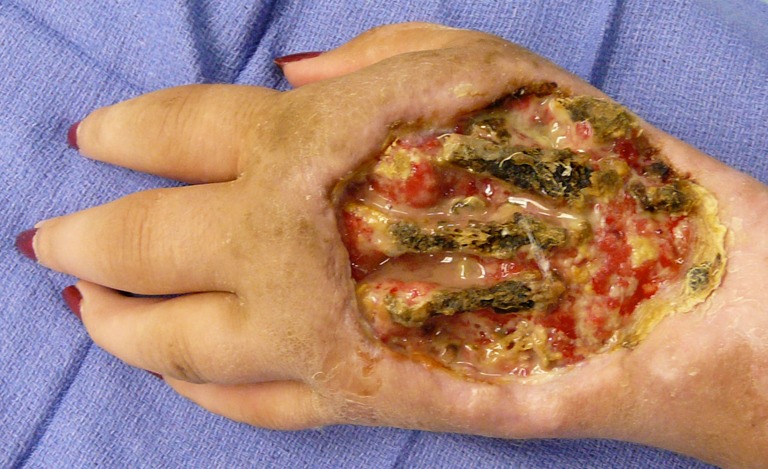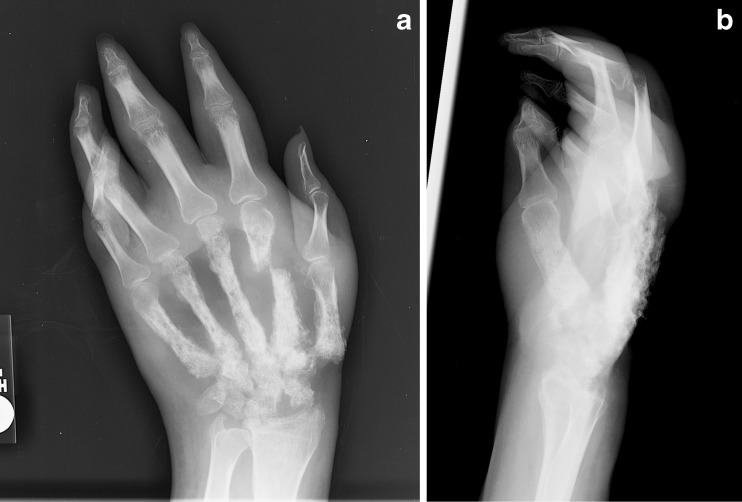A 20-year-old right-hand dominant female presented to the emergency department with a significant ulcerative lesion overlying the dorsum of her left hand with exposed bone. She had arrived in the USA the previous day from Nigeria and was brought to our institution for evaluation. Her only significant medical history included migraine headaches and malaria, the latter of which had been recently treated. Approximately 1 year prior, she had been diagnosed with migraine headaches by her physician and was prescribed intravenous pentazocine (Talwin) for symptomatic relief. She became dependent on the medication and began self-administration, primarily injecting into her distal upper extremities. According to her history, she began to develop superficial cutaneous ulcers on the dorsum of her hands bilaterally approximately 6 months prior to presentation. Her right hand wounds eventually healed and fibrosed, while the left hand continued to worsen. She stated that she was treated on several occasions with a combination of oral and intravenous antibiotics but never underwent formal irrigation and debridement. She was minimally compliant with treatment modalities, however, and continued self-administration of the drug. After progressing to the point where she had lost meaningful function of her hand, her family brought her to the USA for treatment.
Upon presentation, removal of her bandages revealed a grossly contaminated ulceration of the dorsum of her hand with exposure of the second through the fifth metacarpals (Fig. 1). Purulent material surrounded large areas of necrotic bone. The volar surface of her hand remained healthy, and sensation was intact to light touch in the median and ulnar nerve distributions. The dorsum of her hand, however, had limited sensation. She did exhibit minimal motion at the proximal and distal interphalangeal joints with 0–20° and 0–10° of flexion, respectively, but could not actively range at her metacarpohalangeal joints. There was minimal surrounding erythema, but significant edema was present distally. She denied a history of fevers but did endorse occasional chills. Her laboratory values were unremarkable for systemic involvement including a white count of 6.4, ESR of 15, and CRP of 1.9. Her radiographs are shown—revealing diffuse chronic osteomyelitis and osteonecrosis involving the entire carpus, all metacarpals, and the distal radius (Fig. 2). Also noted was a pathologic fracture of her 2nd metacarpal resulting from a fall 2 months prior. Due to the involvement of her contralateral hand, an MRI was ordered to exclude indolent osteomyelitis, which was negative. Tissue cultures grew mixed aerobic and anaerobic bacteria including Morganella morganii. She was given vancomycin, pipercillin-tazobactam, and eventually meropenem after culture growth.
Fig. 1.

Dorsal hand wound with obvious necrotic metacarpal and carpal bones and gross purulence
Fig. 2.
a, b Radiographs of involved hand demonstrating osteomyelitis and necrotic bones
Due to the severity of the insult to her carpus, metacarpals, and distal radius, there were no viable salvage procedures for her hand. A discussion was had with her and her family, and the decision was made to proceed with a guillotine amputation at the level of the distal forearm. Four days later, she had a revision amputation with closure of the skin which she tolerated well.
Discussion
Soft tissue infections from the use of injectable narcotics are commonly seen in emergency departments throughout the USA. In this case, the initial infectious nidus progressed to a necrotizing soft tissue infection eventually resulting in diffuse osteomyelitis. There have been case series reporting necrotizing soft tissue infections resulting from intravenous drug abuse [1]; however, development of contiguous osteomyelitis represents a less common but significantly morbid progression.
There were several unusual clinical constellations in this case. The first was the initial culprit, pentazocine, which is a mixed agonist–antagonist narcotic derived from benzmorphinan. It is largely a drug of antiquity in the clinical setting in developed countries; however, it is still used and abused in North America. Its use was prevalent in the USA in the 1970s, and interestingly, it was associated with pseudomonas infection in drug abusers secondary to its water-soluble preparation [5]. Pentazocine’s destructive cutaneous manifestations including dermal fibrosis, granulomatous inflammation, and vascular thrombosis [7] are well described in the literature and were noted in this case. Tissue and wound cultures grew mixed flora including Gram-positive rods and cocci as well as M. morganii, a Gram-negative bacillus found in the human gastrointestinal tract. While this organism is not often isolated as the causative agent of soft tissue and bone infection, there was a recent case report in a patient from Nigeria describing an incidence of necrotizing fasciitis caused by a strain of this same bacterium [8].
There are relatively few recent publications commenting on pentazocine abuse, likely due to the decreased usage in developed countries. That being said, it remains to be a problem in underdeveloped countries such as Nigeria, where it continues to be prescribed by physicians for management of both acute and chronic pain. A recent case report documents two similar cases in which young adults with sickle cell anemia developed dependence to this drug after undergoing administration in the clinical setting for acute crises [6]. In both cases, the patients went on to become physically dependent and required clinical treatment to wean from the substance. While this will not likely be a common scenario encountered by physicians in developed countries, it deserves mention that this is the second case of a patient with pentazocine dependence that has presented to our institution in the past 6 months (both flown from Nigeria).
While pentazocine use in the USA is certainly not widespread, commonly abused drugs including heroin and cocaine can result in some of the same clinical manifestations via similar mechanisms. Heroin is usually adulterated by the time it reaches the consumer, and among the exhaustive list of diluting substances, quinine is toxic to the surrounding soft tissues [2]. When administered using the common technique known as “skin popping,” cutaneous ulceration from the combined effects of cellular cytotoxicity and vascular thrombosis may occur [3]. The vasoconstrictive effect of cocaine additionally creates a susceptible environment for infection and may even be synergistic with bacterial proteases in causing necrosis [4].
This represents a case of obvious neglect attributable to both the patient as well as her environment. While this patient presented with an uncommon collection of clinical circumstances, it reinforces the devastating sequelae that can result from injectable drug abuse and emphasizes the importance of recognizing and treating these infections early. It also highlights the ongoing problems with abuse of this drug in certain underdeveloped countries and serves as a testament to its potential danger.
References
- 1.Callahan TE, Schecter WP, Horn JK. Necrotizing soft tissue infection masquerading as cutaneous abscess following illicit drug injection. Arch Surg. 1998;133(8):812–819. doi: 10.1001/archsurg.133.8.812. [DOI] [PubMed] [Google Scholar]
- 2.Centers for Disease Control and Prevention Trends in injection drug use among persons entering addiction treatment—New Jersey, 1992–1999. Morb Mortal Week Rep. 2001;50:378–391. [PubMed] [Google Scholar]
- 3.Dunne JH, Johnson WC. Necrotizing skin lesions in heroin addicts. Arch Dermatol. 1972;105:544–547. doi: 10.1001/archderm.1972.01620070016006. [DOI] [PubMed] [Google Scholar]
- 4.Hoeger PH, Haupt G, Hoelzle E. Acute multifocal skin necrosis: synergism between invasive streptococcal infection and cocaine induced ischaemia? Acta Derm Venereol. 1996;76:239–241. doi: 10.2340/0001555576239241. [DOI] [PubMed] [Google Scholar]
- 5.Levin MH, Weinstein RA, Nathan C, Selander RK, Ochman H, Kabins SA. Association of infection caused by pseudomonas aeruginosa serotype O11 with intravenous abuse of pentazocine mixed with tripelennamine. J Clin Microbiol. 1994;20(4):758–762. doi: 10.1128/jcm.20.4.758-762.1984. [DOI] [PMC free article] [PubMed] [Google Scholar]
- 6.Olatunji PO, Makanjuola AB. Pentazocine Abuse in Sickle Cell Anemia Patients: A Report of Two Case Vignettes. African J Drug & Alcohol Studies. 2009;8(2):59–64. [Google Scholar]
- 7.Palestine RF, Millns JL, Spigel GT, Schroeter AL. Skin manifestations of pentazocine abuse. J Am Acad Dermatol. 1980;2(1):47–55. doi: 10.1016/S0190-9622(80)80292-1. [DOI] [PubMed] [Google Scholar]
- 8.Soleimanian S, Gordon NC, Wareham DW. Polymicrobial necrotizing fasciitis involving enterobacteria producing CTX-M-15 extended-spectrum beta-lactamases. J Med Microbiol. 2011;60(Pt 1):135–137. doi: 10.1099/jmm.0.021998-0. [DOI] [PubMed] [Google Scholar]



